I found a solution by adding further constraints:
@property (nonatomic, strong) NSLayoutConstraint *leftFullConstraint;
@property (nonatomic, strong) NSLayoutConstraint *rightFullConstraint;
and initializing the view constraints:
UIView *theView = self.view;
UILayoutGuide *theGuide = theView.safeAreaLayoutGuide;
NSLayoutConstraint *theConstraint;
inWebView.translatesAutoresizingMaskIntoConstraints = NO;
[theView.topAnchor constraintEqualToAnchor:inWebView.topAnchor].active = YES;
theConstraint = [theGuide.leadingAnchor constraintEqualToAnchor:inWebView.leadingAnchor];
theConstraint.priority = UILayoutPriorityDefaultHigh;
theConstraint.active = YES;
theConstraint = [theGuide.trailingAnchor constraintEqualToAnchor:inWebView.trailingAnchor];
theConstraint.priority = UILayoutPriorityDefaultHigh;
theConstraint.active = YES;
[theView.bottomAnchor constraintEqualToAnchor:inWebView.bottomAnchor].active = YES;
self.leftFullConstraint = [theView.leftAnchor constraintEqualToAnchor:inWebView.leftAnchor];
self.rightFullConstraint = [theView.rightAnchor constraintEqualToAnchor:inWebView.rightAnchor];
Note: The new constraints using left and right instead of leading and trailing, because the writing direction is irrelevant! They have a higher priority than the constraints to the save area layout guide. So when the app activates it, they will overrule the constraints to the safe area.
Finally, the constraints are updated when the trait collection changes:
- (void)updateConstraints {
UIDeviceOrientation theOrientation = [[UIDevice currentDevice] orientation];
switch (theOrientation) {
case UIDeviceOrientationLandscapeLeft:
self.leftFullConstraint.active = NO;
self.rightFullConstraint.active = YES;
break;
case UIDeviceOrientationLandscapeRight:
self.leftFullConstraint.active = YES;
self.rightFullConstraint.active = NO;
break;
default:
self.leftFullConstraint.active = NO;
self.rightFullConstraint.active = NO;
}
}
- (void)traitCollectionDidChange:(UITraitCollection *)inPreviousTraitCollection {
[super traitCollectionDidChange:inPreviousTraitCollection];
[self updateConstraints];
}
The same for Swift 4. Defining the properties:
var leftFullConstraint: NSLayoutConstraint?
var rightFullConstraint: NSLayoutConstraint?
Initializing the constraints:
if let theView = self.view {
let theGuide = theView.safeAreaLayoutGuide
var theConstraint: NSLayoutConstraint!
inWebView.translatesAutoresizingMaskIntoConstraints = false
theView.topAnchor.constraint(equalTo: inWebView.topAnchor).isActive = true
theConstraint = theGuide.leadingAnchor.constraint(equalTo: inWebView.leadingAnchor)
theConstraint.priority = UILayoutPriorityDefaultHigh
theConstraint.isActive = true
theConstraint = theGuide.trailingAnchor.constraint(equalTo:inWebView.trailingAnchor)
theConstraint.priority = UILayoutPriorityDefaultHigh
theConstraint.isActive = true
theView.bottomAnchor.constraint(equalTo: inWebView.bottomAnchor).isActive = true
self.leftFullConstraint = theView.leftAnchor.constraint(equalTo: inWebView.leftAnchor)
self.rightFullConstraint = theView.rightAnchor.constraint(equalTo: inWebView.rightAnchor)
}
and updating them:
func updateConstraints() {
if let leftFullConstraint = self.leftFullConstraint,
let rightFullConstraint = self.rightFullConstraint {
let theOrientation = UIDevice.current.orientation
switch(theOrientation) {
case .landscapeLeft:
leftFullConstraint.isActive = false
rightFullConstraint.isActive = true
break;
case .landscapeRight:
leftFullConstraint.isActive = true
rightFullConstraint.isActive = false
break
default:
leftFullConstraint.isActive = false
rightFullConstraint.isActive = false
}
}
}
override func traitCollectionDidChange(_ inPreviousTraitCollection: UITraitCollection?) {
super.traitCollectionDidChange(inPreviousTraitCollection)
updateConstraints()
}
 where the web view is drawn as green area.
where the web view is drawn as green area.